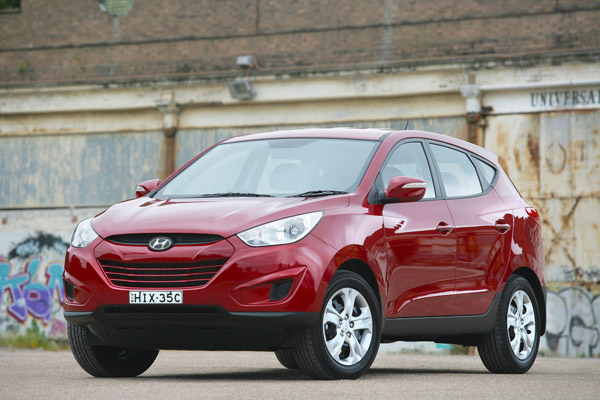
The Hyundai ix35 has something of a split-personality. It began life in 2004 under the
name Tucson, before switching in 2010, to ix35 as part of Hyundai’s move towards
Euro-style alphanumeric names. The arrival of a new model in August 2015 saw the
name return to Tucson.
Most Hyundai ix35s are used as a family wagon rather than SUVs. In all-wheel-drive
format they can be driven on mild forest trails and the like.
In August 2012 the ix35 received a mild facelift and satellite navigation was
introduced in the Elite and Highlander variants. November 2013 saw the arrival of
the Hyundai ix35 Series II.
Mechanical updates including new direct-injection petrol engines and revised
suspension. The turbo-diesel remained virtually unchanged.
Projection headlights with LED positioning lights, aerodynamic roof rails and striking
new alloy wheel designs certainly changed the appearance.
Significant suspension changes to suit Australian conditions and drivers’ desires
were made in the Series II. It has revised coil springs and stabiliser bars front and
rear. A major upgrade was the use of a solid-type sub-frame mount to a more flexible
bush-type system. The latter giving better isolation of impact harshness and vibration
and sharper steering.
Three trim levels are offered: Active, Elite and Highlander, with a choice between
2.4-litre petrol and 2.0-litre turbo-diesel engines.
The topline Highlander is pretty upmarket for its class, with a panoramic glass roof,
leather trim, powered and heated front seats, a rear-view camera, dual zone air
conditioning and a topline audio system. There’s also keyless entry, Aux and USB
port with iPod connectivity, steering wheel mounted audio and cruise control.
There’s good leg and headroom in all seats. Cleverly, the rear seat is on rails to slide
back or forward to permit juggling of seat/luggage space.
Shoulder room in the back is marginal if you want to carry three adults of average
size. The size of the multiple stowage areas inside the cabin is impressive.
Even with all seats in use the Hyundai ix35 still has a generous luggage capacity of
591 litres. This increases to 1436 litres with the rear seats folded down. The loading
platform isn’t too high off the ground and the shape of the cargo area makes it easy
to access.
Hyundai has become a major player in Australia in the recent years. No longer the
maker of cheap ‘n’ cheerful hatches it now has an extensive range of models in
various categories. The ix35 has certainly played its part in one of the fastest
growing areas of all in the sales race.
As a result of this expansion the emphasis on quality customer service has also
grown, as has the number of dealers. Most dealers are in metro areas but there’s an
ever-increasing number in country towns.
We’ve had no real complaints on availability of parts and prices are about average
for this class.
These are relatively simple vehicles, at least by the standard of the early years of the
21st century, and most good amateur mechanics can do a fair bit of work. Don’t
tamper with safety items, though.
Insurance premiums are about average for this vehicle type and there doesn’t
appear to be a lot of difference from company to company.
WHAT TO LOOK FOR
Check out the door trims, carpet fit, including in the boot and the backs of the front
seats as these can be damaged by bad children.
Look at the condition of the engine oil by checking the dipstick. If it’s too dark the
servicing may not have been done on time.
The turbo-diesel engines should start within a few seconds, if not there may be
problems. Definitely one for a professional inspection.
Make sure the automatic transmission shifts gears quickly and without any
shuddering. And that you think it’s in in the correct ratio for the conditions. If there’s
any doubt, have it by a transmission specialist at their premises.
Manual gearboxes that are reluctant to change or crunch during shifts may have had
a hard life. Or it could be the clutch is on its way out.
Off-road use, even gently driven, may have resulted in scratches in the doors from
foliage, scuffs on the corners of the front bumpers and door sills.
Underbody off-road damage is a no-no in a semi-SUV like the ix35 and is almost
certainly a sign to keep well clear of the crossover.
HOW MUCH?
Expect to pay from $5000 to $9000 for a 2010 Hyundai ix35 Active FWD; $7000 to
$11,000 for a 2010 Elite AWD or a 2012 Active FWD; $9000 to $14,000 for a 2011
Highlander AWD or a 2013 Elite FWD; $11,000 to $16,000 for a 2014 Elite AWD;
$12,000 to $18,000 for a 2014 Trophy AWD; and $13,000 to $19,000 for a 2015
Highlander AWD.
CAR BUYING TIP
Beware any all-wheel-drive vehicle designed for even light-duty off-road running.
They may be about to suffer problems that will seriously damage your bank balance.
RECALLS: To browse recalls on all vehicles, go to the ACCC at:
www.productsafety.gov.au/products/transport/cars/